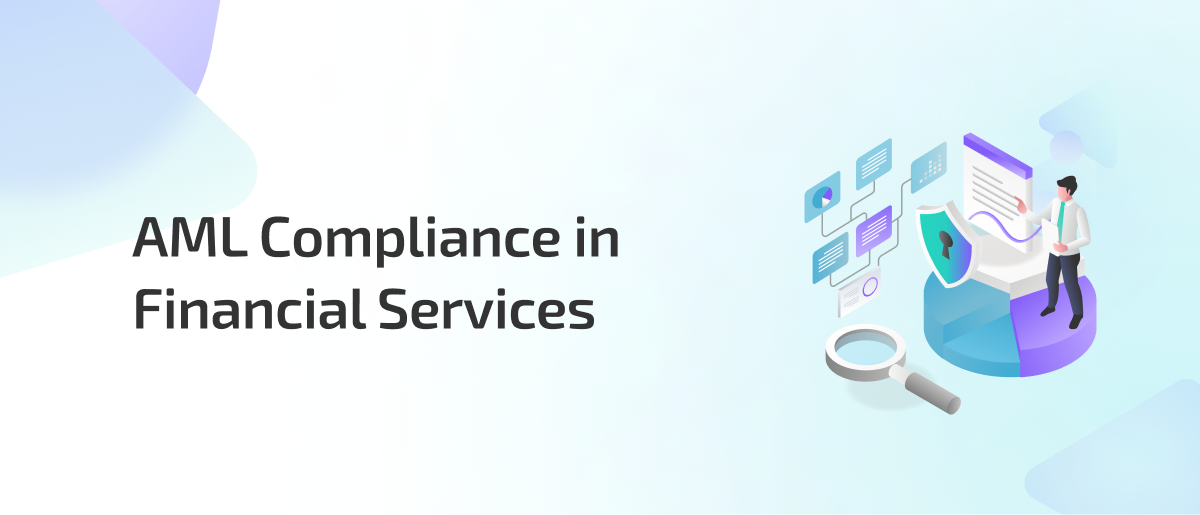.webp)
Published on
September 23, 2025
AML Compliance and Regulatory Best Practices for Financial Services
In this story

Accelerate AML Compliance: Meet Regulatory Demands with 80% Less Setup Time
.svg)
.svg)
AML compliance is essential because financial crimes not only cause significant economic damage but also threaten the integrity and reputation of financial institutions. Regulatory authorities worldwide have increased scrutiny, making adherence to AML laws critical for every financial services firm.
This article aims to provide a clear understanding of regulatory best practices, key compliance components, and how to adapt to emerging AML trends and technologies in a global context. It will break down complex requirements into practical solutions to help strengthen AML programs effectively.
What is AML Compliance in Financial Services?
Anti-Money Laundering (AML) compliance in financial services refers to the rules and procedures banks and financial institutions follow to detect, prevent, and report money laundering and related financial crimes. These regulations are designed to protect the financial system from being used to disguise illegal funds or finance terrorism.
Regulatory Landscape and Frameworks
AML compliance in financial services is governed by a complex network of international, regional, and national regulatory bodies and legal frameworks. These rules define how financial institutions must operate to prevent money laundering and terrorist financing.
At the international level, the Financial Action Task Force (FATF) is the leading authority. FATF develops global AML standards and issues recommendations that countries implement through local laws. FATF’s 40 Recommendations provide a comprehensive framework covering risk assessment, customer due diligence (CDD), reporting suspicious activities, and more.
In addition to FATF, regional regulators like the European Union (with its Anti-Money Laundering Directives or AMLDs), the United States (with laws such as the Bank Secrecy Act and the USA PATRIOT Act), and others impose AML obligations. Financial institutions must comply with their home country’s regulations and also consider international sanctions enforced by organizations such as the United Nations and OFAC (Office of Foreign Assets Control).
Understanding these regulatory layers is essential for AML compliance in financial services because failure to comply can lead to severe penalties, including hefty fines, reputational damage, and loss of banking licenses.
Key Takeaway:
AML compliance in financial services requires navigating global and local regulatory frameworks like FATF recommendations and country-specific laws to ensure all legal obligations are met and financial crimes are effectively prevented.
The Five Foundational Elements of AML Compliance
AML compliance in financial services stands on five essential pillars. These pillars work together to create a robust defense against money laundering and financial crime.
1. Risk Assessment
Financial institutions must regularly assess their exposure to money laundering risks. This includes evaluating customers, products, services, transactions, and geographic locations. The risk assessment drives how resources are allocated and which controls are prioritized.
2. Customer Due Diligence (CDD)
CDD involves identifying and verifying the identity of customers, understanding their financial behavior, and monitoring their transactions. Enhanced Due Diligence (EDD) applies to higher-risk customers, such as Politically Exposed Persons (PEPs) or clients from high-risk jurisdictions.
3. Transaction Monitoring
Continuous monitoring of customer transactions helps detect suspicious activities. Financial institutions use automated systems and algorithms to flag anomalies based on predefined rules, thresholds, and behavior patterns.
4. Reporting Suspicious Activities
When a transaction or behavior raises red flags, institutions must file Suspicious Activity Reports (SARs) with the relevant authorities. Timely and accurate reporting is critical to assist law enforcement and regulatory agencies in investigating illicit activities.
5. Training and Awareness
All employees must receive regular training on AML regulations, internal policies, and how to identify suspicious activities. A strong culture of compliance helps prevent internal risks and encourages vigilance.
Key Takeaway:
A strong AML compliance program is built on five pillars: risk assessment, customer due diligence, transaction monitoring, suspicious activity reporting, and employee training. Each pillar supports proactive detection and prevention of money laundering.
Comply quickly with local/global regulations with 80% less setup time
.svg)
.svg)
Key Components and Processes of AML Compliance
While the five pillars provide the strategic framework, AML compliance is carried out through detailed operational components and processes. These define the practical “how” behind the strategy, what financial institutions do to comply every day.
1. Customer Identification Program (CIP): Implement concrete steps to verify customer identities using documents and data sources at onboarding.
2. Ongoing Monitoring and Review: Continuously analyze customer transactions and update risk profiles to spot and respond to suspicious activity.
3. Sanctions and Watchlist Screening: Use automated systems to check customers and transactions against sanctions lists and watchlists, blocking any prohibited parties.
4. Record Keeping and Audit Trails: Maintain detailed records of customer data, transaction histories, and compliance activities for regulatory review.
5. Internal Controls and Governance: Enforce policies, appoint compliance officers, and conduct regular audits to ensure compliance standards are upheld.
Key Takeaway:
Key components and processes are the operational actions and controls that implement AML strategy daily, turning high-level pillars into effective compliance practice.
AML Compliance in Financial Services Best Practices
Simple, focused practices combined with technology and governance create resilient AML programs in financial services.
- Conduct regular risk assessments to identify and prioritize areas vulnerable to money laundering.
- Implement strict customer due diligence and continuously monitor clients to effectively manage higher-risk profiles.
- Deploy automated transaction monitoring systems to quickly detect and flag suspicious activities.
- Report suspicious activities immediately to regulatory authorities to ensure compliance and avoid penalties.
- Provide ongoing AML training to all employees to keep them informed about new threats and regulatory changes.
- Establish strong leadership and conduct independent testing to maintain the effectiveness and governance of AML programs.
- Utilize AI and automation technologies to improve detection accuracy and streamline compliance processes.
- Keep comprehensive records to support audits and demonstrate your commitment to regulatory compliance.
How Financial Services Are Adapting to AML Innovations
Financial institutions must adapt to new crime tactics by leveraging new technologies and updating their compliance strategies to remain effective.
1. Artificial Intelligence and Machine Learning: AI-driven systems improve transaction monitoring by identifying complex patterns and anomalies beyond rule-based systems. These technologies enhance accuracy and reduce false positives.
2. Automation of Compliance Tasks: Automating repetitive processes such as customer screening, risk scoring, and report generation increases efficiency and allows compliance teams to focus on higher-risk cases.
3. Blockchain and Cryptocurrency Risks: The rise of cryptocurrencies introduces new AML challenges. Institutions must develop controls to monitor virtual asset transactions and comply with emerging regulations targeting these digital assets.
4. Enhanced Data Analytics: Advanced analytics enable institutions to analyze large volumes of data quickly, uncover hidden risks, and make informed decisions in real time.
5. Regulatory Technology (RegTech): RegTech solutions help streamline compliance through tools designed specifically for regulatory reporting, audit trails, and real-time monitoring.
Key Takeaway:
Adapting to AML trends and technologies such as AI, automation, and RegTech is essential for financial services to enhance compliance effectiveness and address emerging risks.
Wrap-up Thought
Most AML discussions focus on prevention, detection, or regulatory compliance. The real future of AML compliance in financial services lies in embracing uncertainty as an asset, not a risk. The unpredictability of financial crime means no system will ever be perfect or foolproof. Instead of chasing a perfect solution, institutions should invest in building adaptive compliance cultures that thrive in ambiguity. In these cultures, human judgment, machine intelligence, and evolving processes collaborate fluidly. This shift from rigid control to adaptive resilience is the true frontier of AML, turning the unknown from a threat into a strategic edge.
9 Common Questions About AML Compliance in Financial Services
Q1. How is AML compliance defined in the context of financial services?
AML compliance in financial services involves the set of policies, procedures, and controls that institutions use to identify, prevent, and report money laundering and financial crimes, ensuring adherence to legal regulations and minimizing risk.
Q2. What are the fundamental pillars supporting AML compliance?
The core pillars that uphold AML compliance include risk assessment, customer due diligence, transaction monitoring, reporting suspicious activities, and staff training and awareness, forming the backbone of effective AML programs.
Q3. What practices are considered most effective for AML compliance?
Effective AML practices consist of conducting comprehensive risk assessments, enforcing strict customer verification processes, ongoing transaction monitoring, prompt reporting of suspicious activities, accurate record keeping, continuous employee education, and employing advanced technology.
Q4. What are the essential elements of a compliant BSA/AML program?
A compliant Bank Secrecy Act (BSA)/AML program typically requires: 1. Strong internal controls; 2. Independent program testing; 3. Appointment of a dedicated compliance officer; 4. Ongoing personnel training; and 5. Comprehensive customer due diligence including enhanced scrutiny for high-risk customers.
Q5. How can one ensure AML compliance when supporting financial advisors?
Ensuring AML compliance while working with financial advisors involves offering clear regulatory guidance, implementing thorough customer identification procedures, monitoring advisor-related transactions, providing regular training, and maintaining detailed compliance records.
Q6. What are the main AML focus areas organizations should prioritize?
The primary AML priorities include: 1. Conducting risk assessments; 2. Customer due diligence; 3. Transaction monitoring; 4. Reporting suspicious activity; 5. Maintaining records; 6. Training employees; 7. Governance and oversight; and 8. Leveraging technology and analytics for improved compliance.
Q7. In what ways do emerging technologies enhance AML efforts?
Emerging technologies like AI, machine learning, automation, and RegTech improve AML efforts by enhancing the detection of suspicious activities, reducing false alerts, boosting operational efficiency, and enabling real-time oversight.
Q8. Why is it critical to continuously evolve AML compliance in financial institutions?
Continuous evolution in AML compliance is vital because financial criminals constantly adapt their methods and regulations change over time. Staying updated ensures institutions manage risks effectively, comply with new laws, and protect their reputation.
Q9. What is an AML compliance program?
An AML compliance program is a framework that financial institutions build to actively guard against money laundering. It consists of clear rules and steps designed to identify risky clients, monitor financial transactions, train staff on detecting suspicious behavior, and report any questionable activities to authorities. This program ensures the institution meets legal obligations while minimizing exposure to financial crime.
Streamline Compliance: Achieve 80% Faster Setup for Fraud Prevention
.svg)
.svg)

How Aseel reduced onboarding time by more than 87% using FOCAL
Learn how FOCAL empowered Aseel to achieve new milestones.
.svg)
.svg)
Mastering Fraud Prevention: A Comprehensive Guide for KSA and MENA Businesses
51% of organizations fell victim to fraud in the last two years, don't be caught off guard, act proactively.
.svg)
.svg)
Featured blog posts
.svg)
AI-Driven Precision in Fraud Risk and AML Compliance
.svg)
.svg)

.svg)
.png)






.webp)




.svg)

_FastestImplementation_Small-Business_GoLiveTime.png)

_HighPerformer_Small-Business_HighPerformer.png)
_Leader_Leader.png)



%20(1).webp)